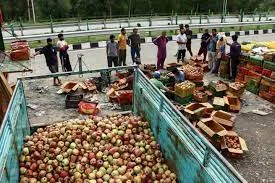As the Himalayan autumn ripens Kashmir’s orchards with over 20–22 lakh tonnes of apples, (which account for over 75% of country’s total production).
The region finds itself trapped in a logistical chokehold. The Jammu–Srinagar National Highway, the arterial route for transporting this produce, is repeatedly shut due to landslides, rockfalls, and subsidence—especially at Thard in Udhampur, where the road continues to sink and only single-lane traffic is allowed.
Trucks are stranded, apples are rotting, and farmers face economic ruin. But this isn’t just a seasonal disruption. It’s a preview of India’s climate future.
Be Future Ready: Climate Change Is No Longer a Forecast
Kashmir is now experiencing cloudbursts, flash floods, and extreme weather events with alarming frequency. According to The Kashmir Monitor and Frontline, over 168 climate disasters struck the region between 2010 and 2022, with 30+ events in August 2025 alone. The Kishtwar cloudburst claimed 65 lives, and river flooding has become a seasonal norm.
This is the new normal. And India’s agro-economy must evolve—or perish.
Transport Breakdown: Railways Offer Symbolic Relief
In response to the highway crisis, Indian Railways launched a daily parcel train from Budgam to Adarsh Nagar, Delhi, carrying just 23 tonnes of apples per day. But with a harvest of 22 lakh tonnes, it would take over 190 years to clear the valley’s produce at this pace.
“Loading of two parcel vans carrying fresh apples from Badgam to Delhi began on Thursday, Sept 11,” — Krishi Jagran
Even with additional wagons, rail remains slow, limited in capacity, and vulnerable to terrain disruptions.
Aerial Logistics: The Infrastructure That Climbs Mountains
India must now treat Kashmir’s apple harvest as a strategic climate-sensitive asset, not just a seasonal commodity. Here’s how aerial logistics—drones and cargo aircraft—can transform the crisis into resilience:
Aircraft Capabilities & Runway Needs
Aircraft Runway Required Payload Capacity India’s Fleet Source
C-130J Super Hercules ~1,200 m (STOL) 20 tonnes 12 Aircraft Eurasian Times
Airbus A400M Atlas ~1,070–1,200 m 37 tonnes 0 (Under consideration) WagenClub
IIyushin II-76 ~2,500 m 40 tonnes ~17 aircraft (aging fleet) Asianet Newsable
Lift Drones
• Spider-i H200: 100 kg payload, 62-minute flight time, 44 km range
• Windracers ULTRA UAV: 100+ kg payload, autonomous long-range delivery
• Use cases: Orchard-to-market delivery, emergency evacuation, integration with e-NAM and FPO networks (Electronic National Agriculture Market & Farmers produce Organisation)
What Governments Must Do—Centre and State
Action Description Lead Agency
Declare Harvest Season Critical Logistics Window Enable aerial corridors and emergency transport Ministry of Agriculture & Civil Aviation
Expand Cold Storage Capacity Beyond the current 3.07 lakh tonnes PMKSY & Horticulture mission
Subsidise Drone & Air Freight for Farmers Through Agriculture Infrastructire Fund (AIF) Ministry of Agriculture
Build Disaster-Ready Mandis With helipads, drone docks, and modular storage State Horticulture Departments
Launch Corp Insurance for Climate Events Cover losses from transport disruption Restructure Weather -based on Crop Insurance Scheme
Corporate Investment: The Missing Link
India’s top conglomerates—Adani, Ambani, Tata, Mahindra, and Aditya Birla are poised to invest $800 billion over the next decade. While much of this is earmarked for green energy and EVs, a fraction must be channelled into Agro-logistics and Climate-Resilient Infrastructure.
Proposed Investment Models:
• Drone-as-a-Service Platforms for FPOs and SHGs (Farmer Producer Organisation)
• Cold Chain Networks with real-time tracking and AI-based spoilage prediction
• Agri-Data Exchanges to connect farmers directly with buyers
• Rural Airstrips and Agro-Hubs co-funded by CSR and PPP models
Global Playbook: What Other Nations Do
Country Strategy Impact
Japan Drone fleets + rail corridors during typhoons Minimal crop loss, fast recovery
USA FEMA + USDA deploy cargo aircraft during hurricanes Direct farmer compensation aerial evacuation
New Zealand Helicopter bridges + modular cold storage -post the 2016 Kaikōura earthquake Saved dairy and fruit sectors from collapse
Conclusion: Let Kashmir’s Apples Fly, Not Rot
Kashmir’s apple crisis is not just a logistical failure—it’s a climate alarm and an economic wound. With ₹600–700 crore in losses this season, and the apple sector contributing nearly 8% to Jammu & Kashmir’s GDP, the stakes are far too high for patchwork solutions.
When a farmer’s harvest is stranded, his smile doesn’t just fade—it freezes in uncertainty.
When crates of apples collapse under landslide delays, so does the promise of a debt-free season.
And when the state scrambles to repair roads instead of reimagining infrastructure, it carries the weight of a broken economy on borrowed time.
India must be future-ready, because cloudbursts, floods, and road collapses are no longer rare—they’re routine.
The answer lies in:
• Aerial logistics that rise above terrain and time.
• Resilient infrastructure built for climate shocks.
• Bold investments from both government and corporate giants—Adani, Ambani, Tata, Mahindra, and Aditya Birla must see agro-logistics as a pillar of national resilience.
Let the Centre and State governments act not just to repair, but to reinvent. Let Kashmir’s farmers know that their produce will reach its buyers—before the smile fades, before the debt returns, before the next cloudburst strikes.
Because when apples reach the market, a farmer’s dignity is restored. And when infrastructure lifts the harvest, the economy breathes easier.
Sources
• Apple production figures: Indian Express
• Highway disruption details: PIB
• Drone capabilities: Spider-i Drone Specs, Windracers ULTRA UAV
• Climate change impact: The Kashmir Monitor, Frontline, UCA News
• Railway relief: Krishi Jagran
• Aircraft specs: Eurasian Times, Asianet Newsable, WagenClub
• Corporate investment data: Economic Times, IBEF


